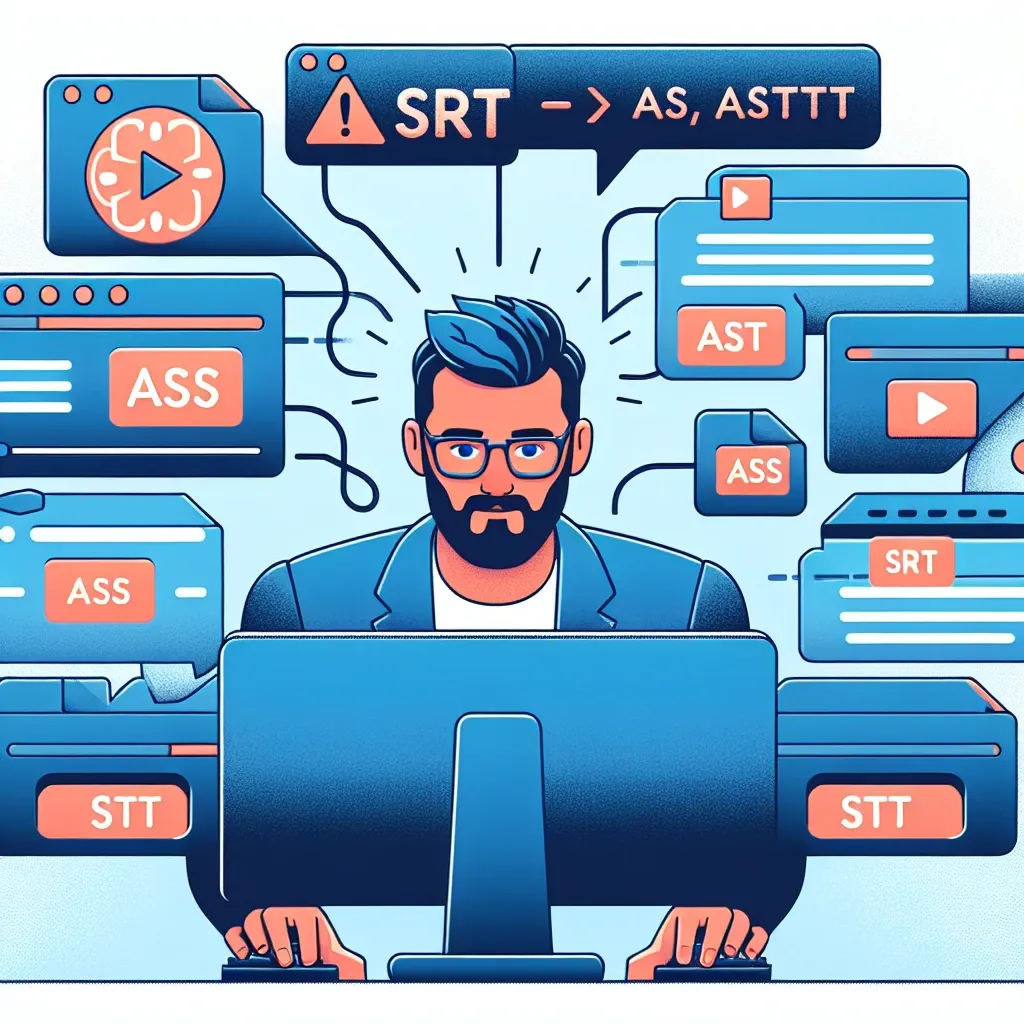Subtitle export has become an essential skill for content creators, video editors, and accessibility professionals in today’s digital landscape. Whether you’re working on YouTube videos, streaming content, or educational materials, understanding how to export subtitles in different formats ensures your content reaches the widest possible audience while maintaining compatibility across various platforms and devices.
Understanding Subtitle Format Fundamentals
Before diving into the export process, it’s crucial to understand the various subtitle formats available and their specific use cases. Each format serves different purposes and offers unique features that make them suitable for particular applications.
Popular Subtitle Formats Explained
SRT (SubRip Text) remains the most widely supported format across platforms. Its simple structure makes it ideal for basic subtitle needs, containing only timing information and text without advanced formatting options. Most video players, streaming services, and editing software support SRT files natively.
VTT (WebVTT) has gained significant popularity, especially for web-based content. This format supports advanced features like positioning, styling, and metadata, making it perfect for HTML5 video players and modern streaming platforms.
ASS/SSA (Advanced SubStation Alpha) offers the most comprehensive formatting options, including custom fonts, colors, animations, and precise positioning. This format is particularly popular among anime and film enthusiasts who require sophisticated visual styling.
TTML (Timed Text Markup Language) represents the industry standard for professional broadcasting and streaming services. It supports complex styling, multiple languages, and advanced timing features required by major platforms like Netflix and Amazon Prime.
Step-by-Step Export Process for Major Software
Exporting from Adobe Premiere Pro
Adobe Premiere Pro offers robust subtitle export capabilities that cater to professional workflows. Begin by ensuring your subtitle track is properly configured within your timeline. Navigate to the File menu, select Export, then choose Captions. The export dialog presents multiple format options including SRT, VTT, and TTML.
For SRT export, select the format and specify your desired frame rate settings. Premiere Pro automatically handles timing calculations based on your sequence settings. Advanced users can customize text encoding options to ensure compatibility with international character sets.
When exporting VTT files, additional options become available for web optimization. You can specify CSS styling references and configure positioning parameters that enhance the viewing experience on web platforms.
Final Cut Pro Export Workflow
Final Cut Pro streamlines the subtitle export process through its integrated caption tools. Access the export options through the Share menu, where you’ll find dedicated caption export settings. The software supports direct export to SRT, VTT, and iTunes Timed Text formats.
The export process includes automatic validation checks that identify potential timing conflicts or formatting issues before finalizing the output. This feature proves invaluable for maintaining subtitle quality across different export formats.
DaVinci Resolve Export Procedures
DaVinci Resolve provides comprehensive subtitle export functionality within its Deliver page. The software supports batch export operations, allowing simultaneous output in multiple formats. This capability proves particularly useful for content creators who need to distribute their work across various platforms with different format requirements.
The export settings include advanced options for burn-in subtitles, which permanently embed text into the video stream. This approach ensures subtitle visibility regardless of player compatibility but reduces flexibility for end users.
Platform-Specific Export Considerations
YouTube Subtitle Requirements
YouTube accepts multiple subtitle formats but shows preference for SRT and VTT files. The platform’s automated processing systems work best with clean, properly timed subtitle files that follow specific formatting guidelines. Avoid excessive line breaks and ensure consistent timing intervals for optimal results.
When preparing subtitles for YouTube, consider the platform’s automatic translation features. Clean, well-structured subtitle files enable more accurate machine translations, expanding your content’s global reach significantly.
Streaming Platform Standards
Major streaming platforms like Netflix, Hulu, and Amazon Prime have specific technical requirements for subtitle formats. These platforms typically require TTML or SMPTE-TT formats with precise timing accuracy and comprehensive metadata inclusion.
Professional streaming submissions often require multiple language versions and detailed quality assurance documentation. Understanding these requirements early in the production process saves significant time during the final delivery phase.
Technical Best Practices for Subtitle Export
Timing Precision and Synchronization
Accurate timing represents the foundation of effective subtitle export. Maintain consistent frame rates throughout your workflow to prevent synchronization issues during format conversion. Most professional workflows use 23.976 fps, 25 fps, or 29.97 fps depending on regional standards and distribution requirements.
Implement proper gap timing between subtitle segments to ensure readability. Industry standards recommend minimum gaps of 2-4 frames between consecutive subtitles, allowing viewers adequate processing time.
Character Encoding and International Support
UTF-8 encoding ensures maximum compatibility across different platforms and languages. This encoding standard supports international character sets, emoji, and special symbols that may appear in modern subtitle content.
When working with multiple languages, consider implementing proper language tags within your subtitle files. These tags enable automatic language detection and improve accessibility for international audiences.
Quality Assurance and Validation
Implement systematic quality checks before finalizing subtitle exports. Verify timing accuracy, text formatting, and character encoding consistency across all output formats. Many professional workflows include automated validation tools that identify common issues like overlapping segments or excessive line lengths.
Test exported subtitle files across different devices and players to ensure compatibility. This testing process reveals platform-specific issues that may not be apparent during the initial export process.
Advanced Export Techniques and Automation
Batch Processing Workflows
Large-scale content production benefits significantly from automated batch export processes. Modern subtitle software supports scripted operations that can process multiple projects simultaneously, applying consistent formatting and export settings across entire content libraries.
Develop standardized export templates that include your preferred settings for different distribution channels. These templates ensure consistency while reducing manual configuration time for routine export operations.
Custom Format Development
Some specialized applications may require custom subtitle formats beyond standard options. Understanding the underlying structure of subtitle files enables the development of conversion scripts that bridge compatibility gaps between different systems.
Professional workflows often include custom post-processing steps that optimize subtitle files for specific delivery requirements. These processes might include automatic text formatting, timing adjustments, or metadata insertion based on project specifications.
Troubleshooting Common Export Issues
Format Compatibility Problems
Compatibility issues often arise when transferring subtitle files between different software platforms. Each application may interpret timing codes differently, leading to synchronization problems in the exported files. Address these issues by maintaining consistent project settings and using intermediate formats when necessary.
Character encoding problems frequently occur when working with international content. Ensure all software in your workflow uses consistent UTF-8 encoding to prevent character corruption during export operations.
Platform-Specific Limitations
Different platforms impose varying restrictions on subtitle file size, timing accuracy, and formatting options. Research target platform requirements thoroughly before beginning the export process to avoid costly revisions later in the workflow.
Some platforms automatically process uploaded subtitle files, potentially altering timing or formatting during ingestion. Account for these automated modifications when preparing your export settings.
Future Trends in Subtitle Export Technology
Artificial intelligence integration is revolutionizing subtitle export workflows through automated quality checking and format optimization. Machine learning algorithms can now identify optimal timing patterns and suggest formatting improvements based on content analysis.
Cloud-based subtitle processing services are emerging as powerful solutions for distributed teams and large-scale operations. These services offer standardized export options with built-in quality assurance and multi-format output capabilities.
The industry continues moving toward more sophisticated subtitle formats that support interactive features, multiple audio descriptions, and enhanced accessibility options. Understanding these emerging standards positions content creators for future platform requirements.
Conclusion
Mastering subtitle export across different formats empowers content creators to reach broader audiences while maintaining professional quality standards. The key lies in understanding each format’s strengths, implementing proper technical workflows, and staying current with platform-specific requirements. Whether you’re working with simple SRT files or complex TTML formats, following established best practices ensures your subtitles enhance rather than hinder the viewing experience. As technology continues evolving, the fundamental principles of accurate timing, proper encoding, and thorough quality assurance remain essential for successful subtitle export operations across all platforms and formats.

